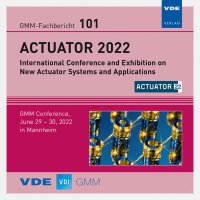Modeling and parameter study of a cooperative flexible array of dielectric elastomer actuators
Konferenz: ACTUATOR 2022 - International Conference and Exhibition on New Actuator Systems and Applications
29.06.2022 - 30.06.2022 in Mannheim
Tagungsband: GMM-Fb. 101: ACTUATOR 2022
Seiten: 4Sprache: EnglischTyp: PDF
Autoren:
Croce, Sipontina; Neu, Julian; Rizzello, Gianluca (Department of Systems Engineering, Saarland University, Saarbrücken, Germany)
Hubertus, Jonas; Schultes, Guenter (Department of Sensors and Thin Films, University of Applied Sciences of Saarland, Saarbrücken, Germany)
Inhalt:
Dielectric elastomers (DEs) are soft electrostatic transducers that, if combined with a mechanical biasing mechanism (e.g., a masse or a spring), are capable of providing a large stroke upon electrical activation. By exploiting this feature in combination with other advantages, like high compliance, energy efficiency, and self-sensing, it is possible to realize flexible structures composed by several cooperative DE actuators, which can be used to enhance the performance of applications such as soft robots and smart wearable skins. Due to spatially coupled electro-mechanical effects, the role of the mechanical biasing system turns out to be crucial for determining the performance of cooperative DE actuators, even more than for their stand-alone counterpart. As an intermediate step towards the realization of cooperative DE systems, a finite element model of a 1-by-3 soft array of electrically independent DEs is presented in this paper. To properly understand how the biasing system affects the actuation performance of the overall array, a finite element simulation study is conducted. Specifically, different types of biasing configurations are considered (pre-scribed force or displacement), and their effects on the coupled actuation performance of the cooperative DE array are compared. The results of this study will serve as a guideline for the development of optimized biasing systems for arrays of DEs.


